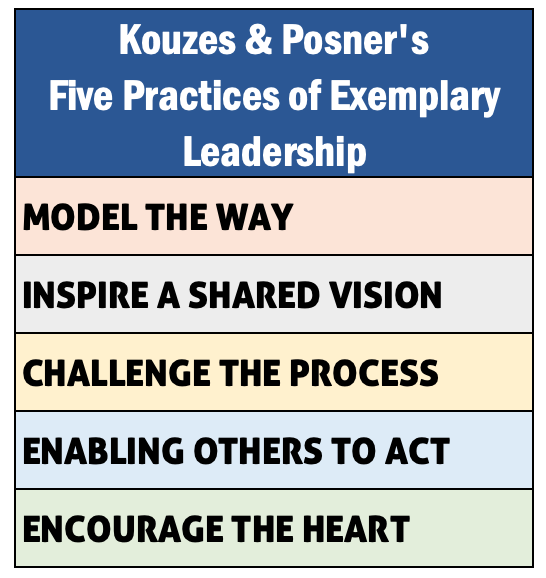In this article, we’ll share Kouzes & Posner’s theory on the five practices of Exemplary Leadership®.
In this post, we’ll be discussing the following (You can click the link below to jump to the section).
- What are the Five Practices of Exemplary Leadership Model®?
- Who are Kouzes and Posner
- What are the Five Practices of Exemplary Leadership Model®?
- Summary
What are the Five Practices of Exemplary Leadership Model®?
As part of our guide on Management and Leadership, we’ve covered a variety of management models and theories from Fiedler’s contingency model, Cost Leadership Strategy to Monroes motivated sequence.
It’s safe to say there are A LOT of management theories and models out there.
Kouzes and Posner had previously developed a leadership model focusing on trait theory, which they further developed in their 5 leadership practices model.
James Kouzes and Barry Posner proposed their variant within their 1987 book The Leadership Challenge.
A functional leadership model, Five practices of exemplary leadership, proposes five practices of exemplary leadership.
(This model is sometimes referred to as Kouzes and Posner’s Leadership Challenge Model.)
Who are Kouzes and Posner
Scholars and executive consultants Kouzes and Posner wrote about the nuances of executive leadership and management in their award-winning book, “The Leadership Challenge”.
The book was originally printed in 1987 and has gone on to sell over two million copies (and has been translated into over 20 languages).
One of the common issues around management is that it feels a little elite. In many organizations, leaders tend to be of a specific type, which might lead you to think only certain individuals can attain the role.
Kouzes and Posner’s model turns this on its head. One of its key foundations is that everyone has innate leadership skills that can be ‘polished’ and developed.
Writing on Success.com Posner wrote, “in excellent organizations, everyone, regardless of title or position, is encouraged to act like a leader.”
In an interview with Graziadio Business Review Kouzes stated that one of the principles of effective leadership was “to make sure that other people will be willing to follow you. Unfortunately, management education doesn’t place enough emphasis on leadership skills.”
Instead, Kouzes and Posner argued that there were five practices that individuals could execute to deliver exemplary Leadership.
Kouzes and Posner continue to develop the theory investigating how such a model is implemented across organizations, refining it as lessons are learned.
What are the Five Practices of Exemplary Leadership Model?

The five practices are:
1. Model the way
The leader sets a behavioral standard to be shared throughout the organization and then epitomizes them.
There is a perceived requirement to establish a standard and, through that standard, deliver benefit.
By following this approach, the ‘leader’ sets an example to the organization.
Behaviors:
- Epitomize the standards to be set through exhibiting behaviours that reflect the desired organizational values.
- Build progress through a series of wins that help achieve confidence and commitment.
2. Inspire a Shared Vision
A vision is a strong image of how/what/where you want your business to be at some point in the future,
This is usually based on goals and ambitions and utilizes powerful and strong language and imagery that act as a method of inspiring people.
Leaders should develop a strong vision before looking to engage others.
Behaviors:
- Develop and communicate a strong and exciting vision of the future.
- Utilize this common vision to attract others through aligning it to common values and aspirations.
3. Challenge the Process
By looking to “Challenge the Process“, a leader seeks ways for the business to develop and improve.
Challenging usually requires analysis and questioning and carries with it risk and learning from mistakes (if you want more info on this topic we’ve put a post together on Gibbs Reflective Cycle that might help). This process typically reviews processes and systems, identifying those that don’t work or could be improved.
By undertaking this process, ‘leaders’ look to provide a catalyst for change.
Behaviors:
- Challenging, questioning, and analysis
- Innovative and willing to try something new.
- Ability to learn from mistakes.
4. Enabling Others to Act
One of the most important acts of leadership is to enable others.
A leader does not try and do everything themselves.
Enabling usually requires a series of ingredients such as processes, tools, delegation, trust, communication, and collaboration.
It is not enough to encourage people to act; you also need to provide the right environment where it flourishes.
Behaviors:
- Delegation & Trust,
- Collaboration
- Communication
- Developing skills and competence.
5. Encourage the Heart
Once a task has been completed, a leader must then recognize and praise the team who has accomplished it.
Encouragement can be a key method of achieving team motivation.
Behaviors:
- Recognition
- Team focus
- Enables group celebration of achievements
- Sticking to targets
Summary
Kouzes & Posner’s theory provides an interesting take on the ingredients that drive effective leadership.
Perhaps the most interesting take home is the belief that anyone can develop skills that enable leadership.
For many, the key barrier to attaining management roles is the belief that they are simply not cut out for it (i.e., that it is a born with, not learned skill).
If there is one thing that is to be learned from this model, it is that leadership is learned and that anyone can do it.
This article is part of our Management and Leadership guide.